Braška (pronounced Brashka)
Braška Presentation
Weldon Mersiovsky
21 February 2010
Quarterly Meeting
Texas Wendish Heritage Society
I am delighted to be here today, as a presenter at a regular meeting of the Texas Wendish Heritage Society, to explain one of the Wendish traditions
that has come to mean a lot to me and my family and hopefully, maybe yours too. We are going to do a word study on the word braška and
explore how we can reincorporate a long standing Wendish tradition back into the folk life of the Texas Wends.
Exactly what does the term braška mean? In the New Testament it means “governor of the feast.” In the Wendish tradition it means, loosely
translated, wedding organizer or facilitator.
We will explore, first of all, the term braška as found in the New Testament, the Gospel of John, Chapter 2:8-9, as it was used in the time
of the wedding at Cana, we need to go to the original language, Koine’ Greek. Here we see that the word is archetrixlinos. 9
ως δε εγευσατο ο
αρχιτρικλινοςτο υδωρ
οινον γεγενημενον και ουκ
ηδει ποθεν εστιν οι δε
διακονοι ηδεισαν οι
ηντληκοτες το υδωρ φωνει τον
νυμφιον ο αρχιτρικλινος
Archetrixlinos has its origins from the Greek word for a supervisor of a dining room or table master. The Greek word arche means
ruler and a trixlinium is a compound of treis and klino (a dinner-bed, being composed of three couches). When the Greeks
compounded arche and trixlinum we get archetrixlinos, director of the entertainment -- governor (ruler) of the feast. The
archetrixlinos had the duty to put in place the tables and couches, arrange the courses, and taste the food and wine before hand, among other
things.
Martin Luther translated archetrixlinos as “Speisemeister” or “master of the food.”
We go now to the Wendish Bible given to my grandmother Mary Lorenz Mersiovsky. This Bible was a confirmation gift from her uncle Peter Kieschnick.
Mary’s father was Andreas Lorentschk who came over on the Ben Nevis.
In the Wendish Bible of 1881 and earlier, the translator of the German version into Wendish translated archetrixlinos as braška.
From Wendish to English, braška becomes “governor of the feast.”
The Wends took the term braška and by the time our ancestors came to this country, it had evolved into a term associated primarily with
weddings and then in this country devolved out of existence.
Dr Gerald Stone, in his work, The Smallest Slavonic Nation, states, “Of all Sorbian social occasions, perhaps the wedding is the most
spectacular. Special forms of the national costumes are worn and many old wedding customs are observed. The central organizational part is played by
the braška, (known in Lower Lusatia as the pobratsch or druzschba, German is Hochzeitbitter), who is responsible
for inviting the guests, directing festivities and making speeches at the appropriate points in the proceedings. He wears a frock-coat and carries a
decorated stick as a sign of his office. His top hat is trimmed with a nosegay and a long silk band.”
David Goeke, of San Antonio, and a Texas Wend, translated for me, Feste Und Volksbraueche Der Sorbenby Edmund Schneeweis. Schneeweis quotes
Sorbian scholar, Michael Hornik. The invitation given by the braška is as follows:
“We have a few words to speak. Be so kind and do not be upset with us on this account. We were sent, first from our dear God, and then from the
honored young people Jan Kowar and his bride Hanna Matthijetz and their parents. All of them heartily invite you to the wedding. If you would, gather
next Tuesday at 8am at the house of the groom to eat a little breakfast and accompany us to the bride’s house. There you will be greeted by friends
and strengthened with beer. Then you will go with us to the church and once inside, pray the Lord’s Prayer silently, in the first place for ourselves
and then sing for the bridal pair and implore God’s blessing for their marriage. From the church, you will return with us to the noon meal and eat,
drink and be happy guests. The happier the better, because a wedding is not a funeral! In all of the fun, we do not want to forget our dear God. On
the contrary, we will keep him constantly in our thoughts. There, we will give them out of love, what God would have us give them, if it is only bread
and salt! We hope, however, for something more from our dear God, because He is almighty and can make out of a little, much, and out of much, little.
Give us now your short reply (our RSVP), which will not only please us, but also those who sent us.
How and what the braška consistently did and how he was consistently costumed after the Wends came to Texas in 1854 varies due to location
and family. In 1954, when Anna Blasig wrote her book, The Wends of Texas, as a Master’s thesis at the University of Texas, this is what she
said,
“Before the wedding procession left for the church, the guests who had arrived at the bride’s home sang a song led by the braška who also recited
the Lord’s Prayer.
The braška, who was a young married relative of the groom, entered the church first, followed by the bride and groom.
The braška was in charge of serving the refreshments. It was his duty to invite the guests to the table and to say grace. He and his helpers served
drinks during the entire wedding celebration.”
Lillie Moerbe Caldwell in her book, Texas Wends, elaborates on the information provided by Anna Blasig.
Anna Blasig was the oldest daughter of Rev Herman Schmidt, my great uncle and the third pastor of St Paul’s in Serbin from 1922 to 1948. There is no
doubt in my mind that much of what she wrote about came to her via Uncle Herman, as he was born in 1875 south of Northrup and grew up in Serbin before
he went off to school.
How the braška was attired in the early days after the arrival of the Wends in Texas will be hard to determine unless we have pictures, letters, or
descriptions. Some of you may have the information either from first hand conversations with older Wends, or from pictures or letters.
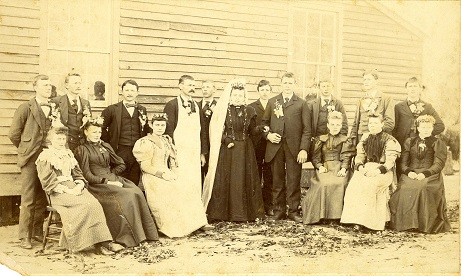
What I have are some pictures passed on down to me from within my family. On 25 Jan 1898, my great aunt Linna Mersiovsky, German, married John Kubsch,
Wendish, here in Serbin. Her brother Ernst Mersiovsky, who married Anna Jacobik in 1896 in Serbin was the braška. Note the apron that he is
wearing in this picture of the wedding party and his corsage.

In this picture Ernst, the braška is wearing his apron and he is sitting with the men. The bridegroom is standing behind him.
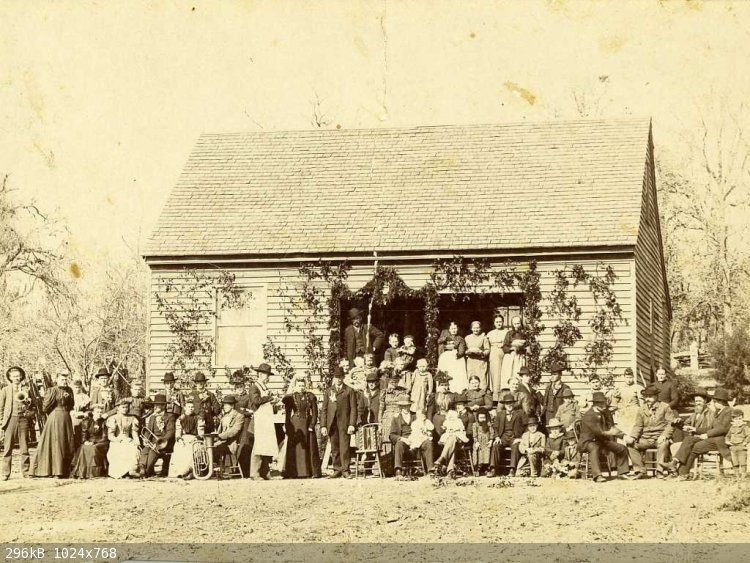
The next two pictures are of the entire wedding celebration. One a picture of everyone in front of the original Mersiovsky home and the next 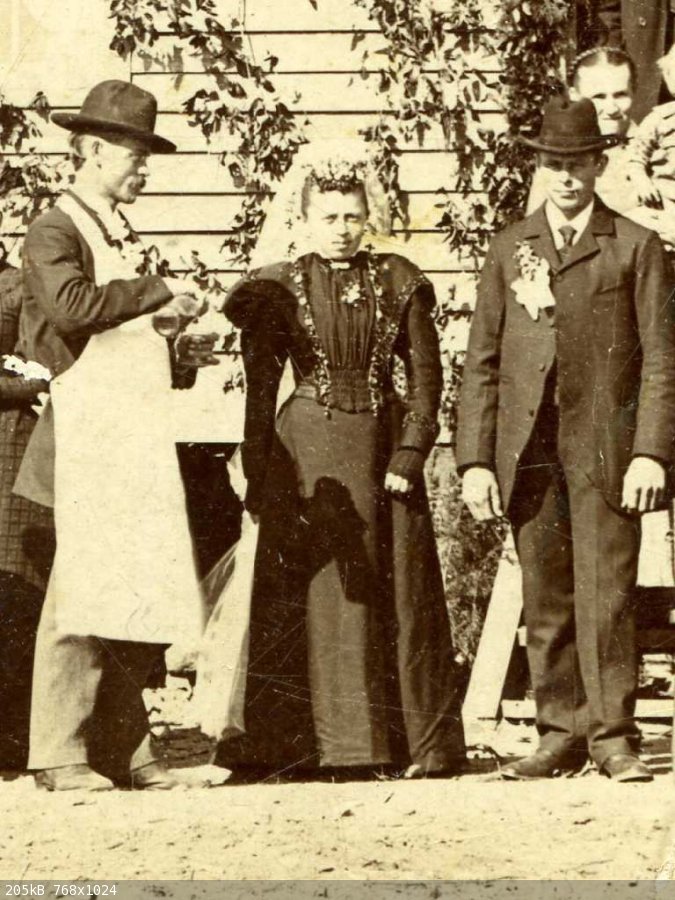 a close up of the same picture showing the braška standing next to the bride and groom pouring out of a bottle into a glass. a close up of the same picture showing the braška standing next to the bride and groom pouring out of a bottle into a glass.
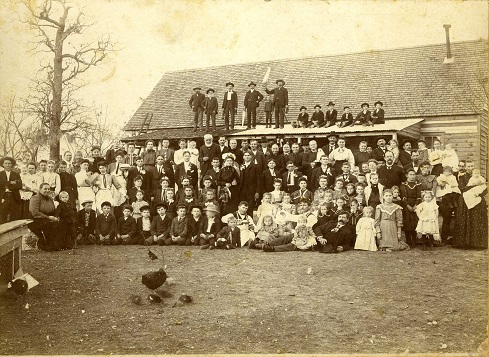 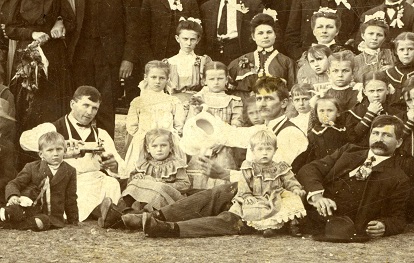
On January 10, 1907, my grandparents, Ben Schmidt, Wendish, and Emma Jurk, Wendish, were married in Warda, Texas. This picture was taken in front of
the no longer standing old Jurk homeplace. Note the two men sitting on the ground in front of the wedding couple wearing aprons. We have now gone from
having one braška to having two. The unidentified braška to the left is pouring wine out of a bottle into a glass. The
braška to the right, pouring out of a pitcher into a glass is Carl Schmidt, brother of the groom. If you look closely the glass on the right
has foam on top and the glass on the left has no foam.
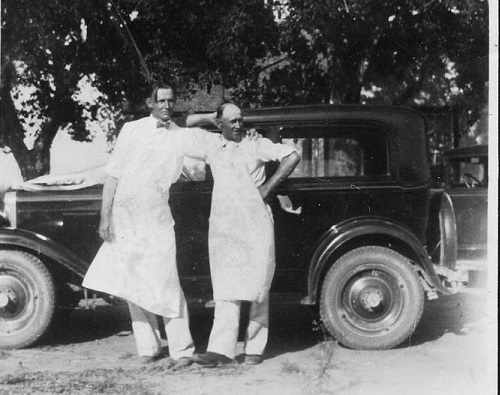
On 14 Jul 1935, my aunt Frieda Mersiovsky, German/Wendish, married Ben Domel, Wendish, in Walburg. Oscar Mirtsching and Alvin Arldt were the
braškas.
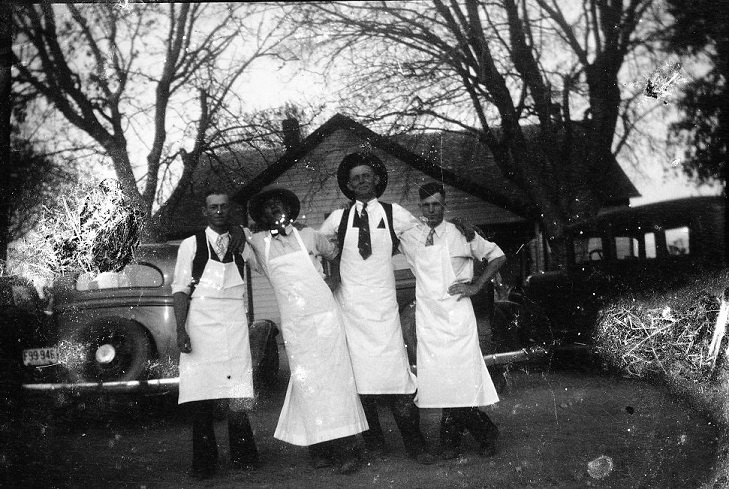
On October 9, 1938 in Walburg, Nelma Dutschman, German/Wendish, married my uncle Bill Mersiovsky, German/Wendish. We have now gone from two
braškas to four. My father, Walter Mersiovsky, is on the left, Alvin Brabandt is next, then Oscar Mirtsching and then Erich Domel. I asked
Erich Domel who still lived in Walburg, if he ever was a braška and he said he was. When asked what that meant, he said he was an usher. What
does that mean? “Well, they made sure that everyone got something to eat, especially the older folks. Some of us carried beer around and wine. When we
did that, we wore white aprons.”

When my daughters got married, I had braškas help me. I asked the husbands of the ladies in the “house party” if they would help pass around
the beer, wine and champagne. Each got an apron with the word braška on it.
When my wife, Jean, and I have a party at my house, I wear a white apron with the word braška on it. I am the governor of the feast. Now what
that means is that I get to tell my wife what to do and she gets to tell me where to go. When people ask me what the word means, I tell them the story
of the wedding at Cana and that my job is to make sure that the good wine gets drank first.
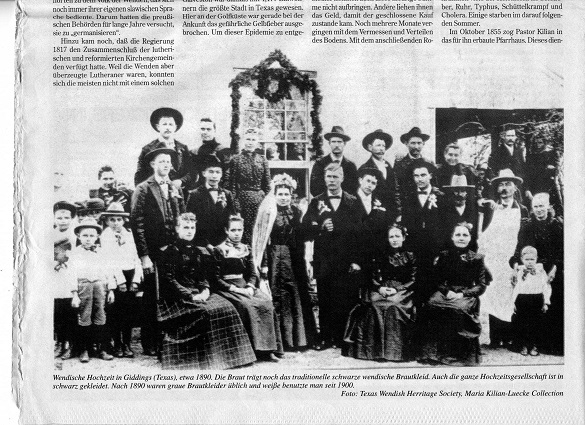
On August 2 my wife, Jean, and I were re-organizing and re-arranging our family history room and she showed me a copy of a German language newspaper,
the Americka Woche, that she had found in he stack of stuff. I did not remember the paper at all. It was addressed to Heinze Voss of Houston,
Texas. That name was not familiar to me. I almost threw it away except that I decided to look through it to see if there was a reason that I might
have it. As I looked through it, I came to the middle pages and saw the article, Von Spreewald nach Texas. That got my attention. At the bottom of the
article was this picture, a wedding picture from the Kilian collection. See the braška. The picture came from the Wendish Museum. Well, I
thought, maybe there are more pictures in the museum.
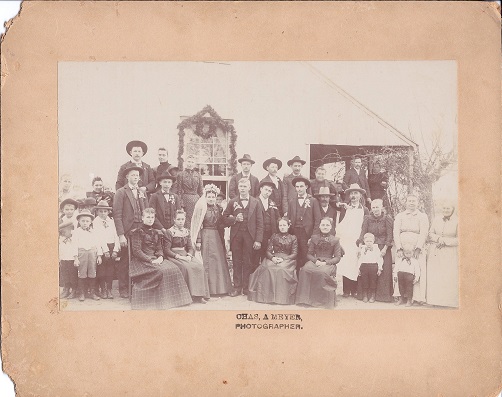
I went down to the museum and found the picture in the German paper which was donated by Laverne Gersch. I asked Laverne about the picture and she
said that the couple was Bertha Zoch, Wendish, and Ernest Biar, Wendish, married on 28 Aug 1914 in Serbin.
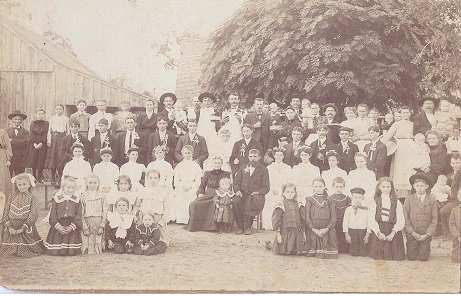 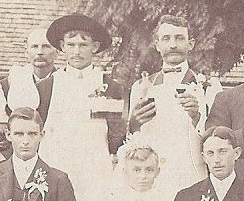
Hanging in our museum is this picture of the wedding party of Lena Beisert, Wendish, and Adolph Sanders, German, on 31 Oct 1905 in Lincoln. It is from
the Ted Wukasch collection. We have two braškas.
I went to the binders in the museum that have photocopies of all of the pictures in the archives and found the following along with the Zoch-Biar
wedding picture. If you were not aware of it, copies of all of the pictures in the museum are in several large binders in the library. Each picture
has a page on which people can see where the picture came from and who is in it. If the subjects are not identified, you can write who you know it to
be or who think it is. All that we ask is that you identify yourself as the source of the information so we can follow up on it.
What follows next are two pictures from the John Biar collection.
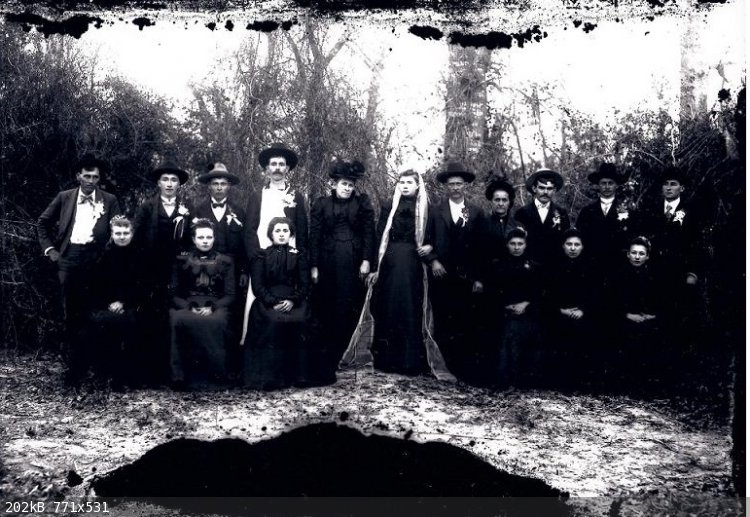
First just the wedding party and then
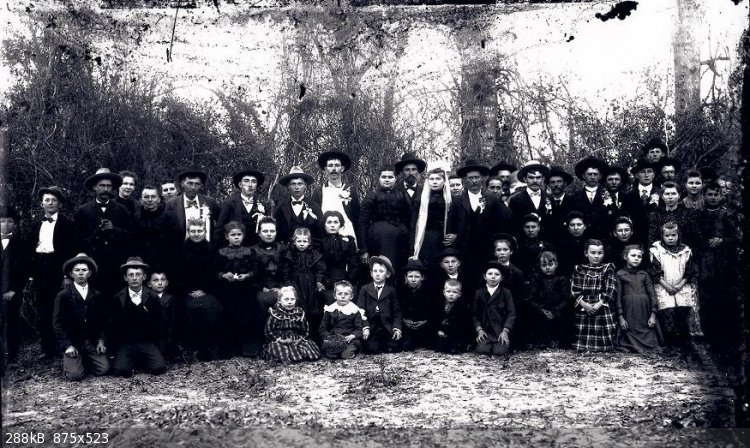
probably the extended family.
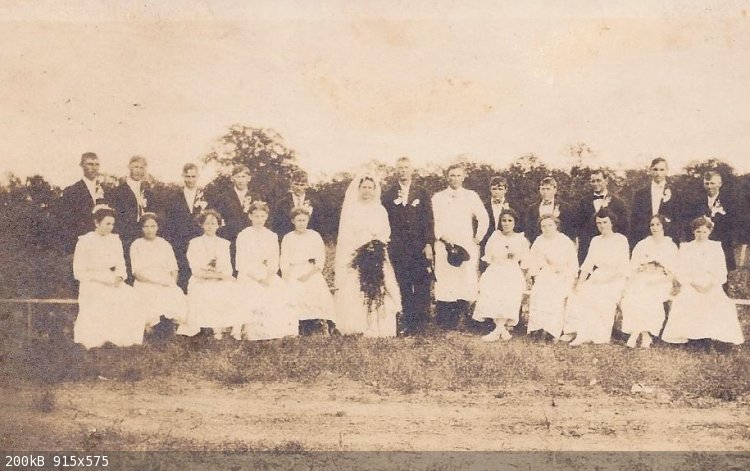
From the Annie Tschatschula collection, an unknown wedding party
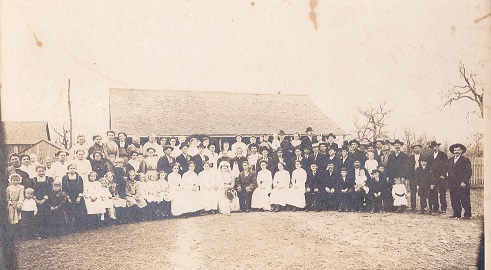 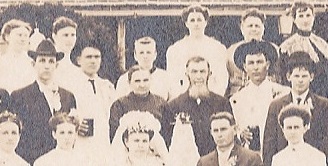
An unidentified picture found in the binders and then a zoom in to get the two braškas.
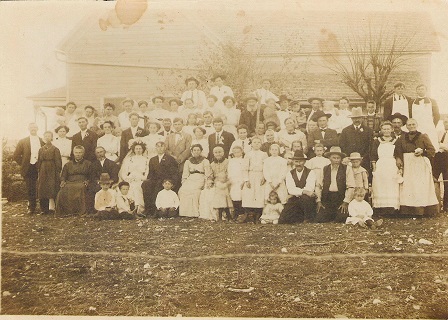
I then asked CB Neitsch of Walburg if he had any pictures of his ancestors in which there might have been braškas. He sent me this picture.
This is of the 1912 wedding of Karl Johann Oswald Neitsch, Wendish, and Selma Emma Marie Kunze, German, in Walburg/Theon, Texas.
From Blasig, Caldwell, Stone and others, we learn that braškas had a unique position of responsibility in Wendish weddings in both Germany
and this country. Before and during the wedding they had a unique function more like the German custom of Hochzeitbitter or wedding
organizer. During the celebration following the ceremony they were more like the governor of the feast. In the pictures that I showed you the
braškas wore white aprons either to signify what they were or because they wanted to keep clean. Initially, they led the wedding party and
managed the festivities. Later they became ushers and eventually the function and term disappeared. We saw examples from the communities of Serbin,
Warda, Loebau, and Walburg. Where the Wends went, some of their customs went with them and became modified over time until they went out of existence.
We are hoping that the term can be regenerated in an effort to preserve the memory of a unique Wendish custom.
Ask your oldest living relatives of their recollections of braškas in Wendish weddings. Look in your picture boxes to see if you might have a
picture that includes a man or men in a white apron. If you find one, make a copy and donate it to our museum. Think of ways that you can incorporate
a braška into your personal feasts and parties.

Zion Lutheran Church in Walburg has an annual Wurstbraten on the first Monday each November. Carroll Fuchs, who is a German from Buckholts and his
bride, Carolyn nee Dunk, from Jarrell, are our braškas. Included in the picture are Earline nee Arldt Reichenbach and Weldon Mersiovsky.
As you know, each activity, whether church, community, or family has someone in charge. I would like to suggest that you look for ways to incorporate
a braška into your activities and explain what it was and who it is.
The museum has made braška aprons available for purchase. If you can think of a way to incorporate the tradition of wearing a white apron at
your family, community, or church activities, and would like one or more, please stop at the museum to get yours.
Note: braška alternate spellings: brashka, braschka, braska.
|